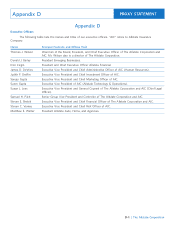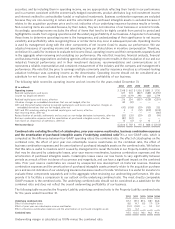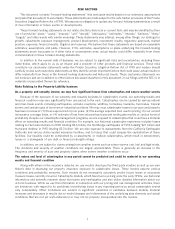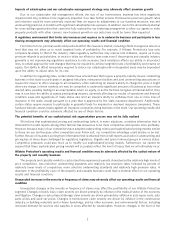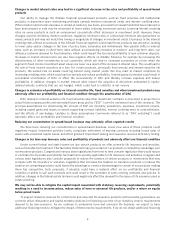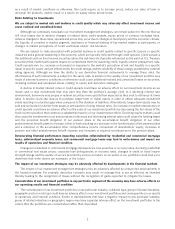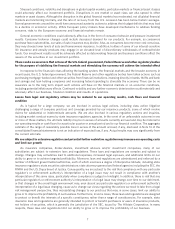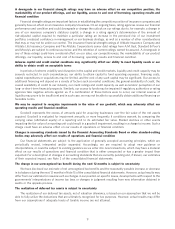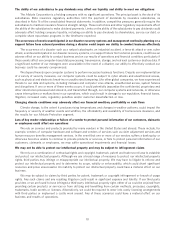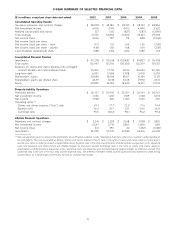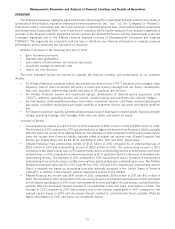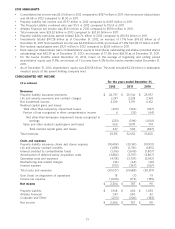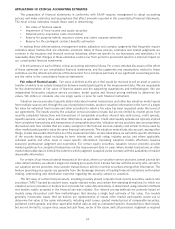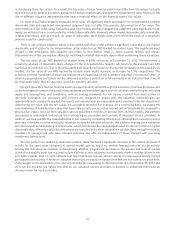Allstate 2013 Annual Report Download - page 122
Download and view the complete annual report
Please find page 122 of the 2013 Allstate annual report below. You can navigate through the pages in the report by either clicking on the pages listed below, or by using the keyword search tool below to find specific information within the annual report.The determination of the amount of realized capital losses recorded for impairments of our investments is
subjective and could materially impact our operating results and financial condition
The determination of the amount of realized capital losses recorded for impairments vary by investment type and is
based upon our ongoing evaluation and assessment of known and inherent risks associated with the respective asset
class. Such evaluations and assessments are revised as conditions change and new information becomes available. We
update our evaluations regularly and reflect changes in other-than-temporary impairments in our results of operations.
The assessment of whether other-than-temporary impairments have occurred is based on our case-by-case evaluation
of the underlying reasons for the decline in fair value. Our conclusions on such assessments are judgmental and include
assumptions and projections of future cash flows which may ultimately prove to be incorrect as assumptions, facts and
circumstances change. Furthermore, historical trends may not be indicative of future impairments and additional
impairments may need to be recorded in the future.
The determination of the fair value of our fixed income and equity securities is subjective and could materially
impact our operating results and financial condition
In determining fair values we principally use the market approach which utilizes market transaction data for the
same or similar instruments. The degree of management judgment involved in determining fair values is inversely
related to the availability of market observable information. The fair value of assets may differ from the actual amount
received upon sale of an asset in an orderly transaction between market participants at the measurement date.
Moreover, the use of different valuation assumptions may have a material effect on the assets’ fair values. The difference
between amortized cost or cost and fair value, net of deferred income taxes, certain life and annuity DAC, certain
deferred sales inducement costs, and certain reserves for life-contingent contract benefits, is reflected as a component
of accumulated other comprehensive income in shareholders’ equity. Changing market conditions could materially
affect the determination of the fair value of securities and unrealized net capital gains and losses could vary significantly.
Risks Relating to the Insurance Industry
Our future growth and profitability are dependent in part on our ability to successfully operate in an insurance
industry that is highly competitive
The insurance industry is highly competitive. Our competitors include other insurers and, because some of our
products include a savings or investment component, securities firms, investment advisers, mutual funds, banks and
other financial institutions. Many of our competitors have well-established national reputations and market similar
products.
We have invested in growth strategies through the recent addition of the Esurance brand, our differentiated
Encompass package policy and our distinctive advertising campaigns. If we are unsuccessful in generating new business
and retaining a sufficient number of our customers, our ability to increase premiums written could be impacted. In
addition, if we experience unexpected increases in our underlying costs (such as the frequency or severity of claims
costs) generated by our new business, it could result in decreases in our profitability and lead to price increases which
could impair our ability to compete effectively for insurance business.
Because of the competitive nature of the insurance industry, there can be no assurance that we will continue to
effectively compete with our industry rivals, or that competitive pressures will not have a material effect on our
business, operating results or financial condition. This includes competition for producers such as exclusive and
independent agents and their licensed sales professionals. In the event we are unable to attract and retain these
producers or they are unable to attract and retain customers for our products, growth and retention could be materially
affected. Furthermore, certain competitors operate using a mutual insurance company structure and therefore may have
dissimilar profitability and return targets. Our ability to successfully operate may also be impaired if we are not effective
in filling critical leadership positions, in developing the talent and skills of our human resources, in assimilating new
executive talent into our organization, or in deploying human resource talent consistently with our business goals.
Difficult conditions in the global economy and capital markets generally could adversely affect our business and
operating results and these conditions may not improve in the near future
As with most businesses, we believe difficult conditions in the global economy and capital markets, such as
significant negative macroeconomic trends, including relatively high and sustained unemployment, reduced consumer
spending, lower residential and commercial real estate prices, substantial increases in delinquencies on consumer debt,
including defaults on home mortgages, and the relatively low availability of credit could have an adverse effect on our
business and operating results.
6



